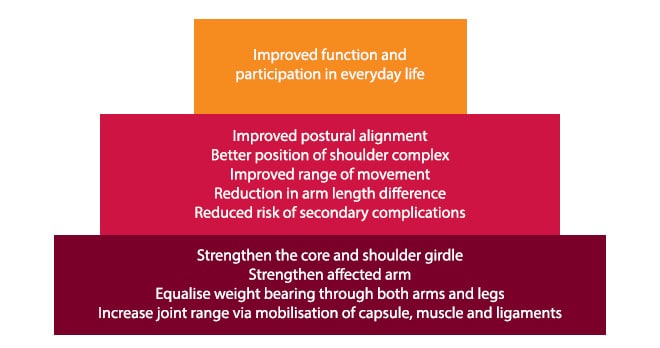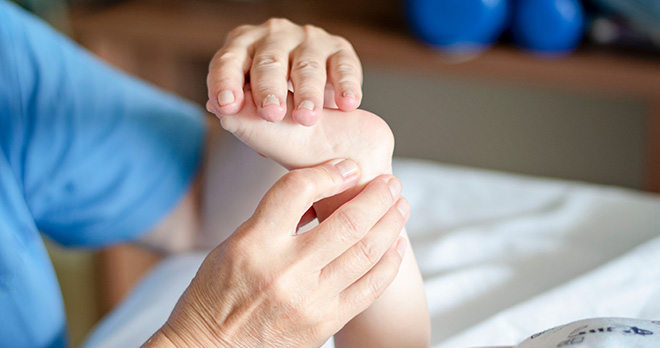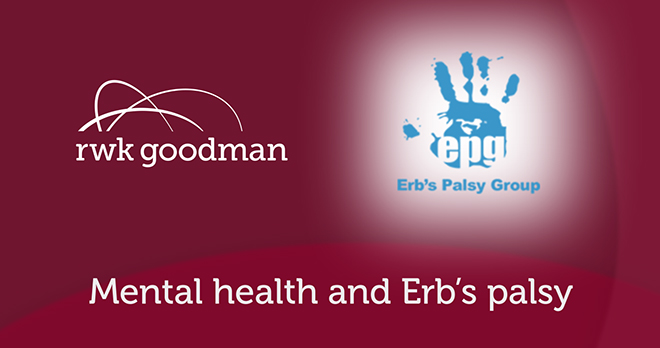Positive treatment: the benefits of core stability and strengthening in Erb’s palsy

The areas of focus of these exercises are core stability and strengthening, both of which can help someone with Erb’s palsy regain as much use of their arm as possible.
What issues does someone with Erb’s palsy face on a daily basis?
Erb’s palsy may cause:
- shortening of the affected limb
- weakness and / or stiffness of the affected limb
- disuse of the affected limb
- loss of sensation / awareness of the affected limb
- altered posture (including winging of the scapula)
- protective muscle spasms
- pain and reduced function, increasing in older age
- unsightly scarring from surgery
- increased risk of falling or injury from a fall, due to loss of / impaired saving reactions
- increased stress on the musculo-skeletal system, leading to pain and dysfunction, due to abnormal compensatory strategies
- difficulties with everyday tasks such as washing, dressing and feeding
- poor body image perception due to differences in shoulder appearance, muscle bulk and arm length
- difficulty getting clothes to fit due to reduced muscle bulk and / or sloping shoulder.
Why focussing on strengthening the ‘core’ and shoulder girdle muscles can help
The diagram below shows the importance of having good ‘building blocks’ as a foundation for improving functional skills. Without the lower levels of the pyramid it is harder or near impossible to achieve the skills at the top of the pyramid.

Guide to Strengthening
| ✔ | ✘ |
|
The participant needs a precise understanding of what they should be working on. It is essential to get appropriate advice and guidance from a physiotherapist, prior to embarking on a new programme. A range of exercise can be undertaken to strengthen the ‘core’ muscles of the trunk, for example:
|
It is vital that the muscles on the front of the chest wall or those that elevate the shoulder are not over-strengthened. Take advice and minimise the use of compensation strategies as although it may result in succeeding at a task in the short term it may increase secondary complications, such as pain, stiffness and deformity in the longer term. Specific exercises may also be required, to alleviate the secondary consequences of these compensatory strategies. |
Why might someone find it difficult to undertake these exercises?
Often, a patient with Erb’s palsy may be worried that they will not be able to improve and they may also have concerns about going to a gym or the appearance of their limb.
Strengthening the core can take time, which requires commitment from both them and their therapist – something that can create difficulty if the patient is concerned they will see no improvement. However the idea of this therapy centres on the quality of exercise rather than quantity of exercises undertaken, so ideally only a small amount of ‘good’ exercise should need to be done each day, with two to three times a week being a minimum. Therefore, any benefits / improvements may not be seen until six to eight weeks into the programme.
The cost of attending a gym or poor access to appropriate physiotherapy may also prevent people from participating in this programme and realising the potential benefits that it can offer. In cases where the Erb’s palsy is a result of negligent treatment, these costs can and should be included in the claim, to make sure the claimant receives the therapy they need in a timely manner, both now and for the future.
The information contained in this blog has been provided by way of a guide and anyone embarking on an exercise regime should seek an independent review of their physiotherapy needs to ensure it is suitable for them.
With thanks to Katie Worley MCSP a specialist Physiotherapist and Associate at Edwards & Associates Ltd, who has helped us produce this information.
If you have any more questions for medical experts in the field of Erb's palsy, make sure to tune in on the evening of 11 March to our free Erb's Palsy Legal Clinic.

Read our guide to Erb's palsy
We’re here to help you understand Erb’s palsy. Causes. Symptoms. Treatment. Whatever you need to know, we’ve got you covered.
Find out more about causes, symptoms, support and legal issues in our guide to Erb’s palsy.
Contact our enquiries team to find out whether our expert birth injury solicitors can help you make a claim for compensation.
Call now







